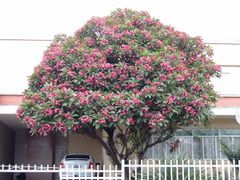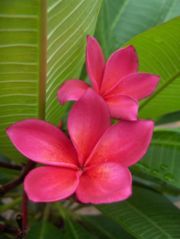Plumeria rubra: Difference between revisions
No edit summary |
No edit summary |
||
| (One intermediate revision by one other user not shown) | |||
| Line 1: | Line 1: | ||
{{Inc| | |||
Plumeria rubra, Linn. Frangipani. Low tree or shrub: lvs. 5- 8 in. long: cymes spreading; corolla-lobes broadly oval, longer than the tube. Mex. to Guiana and Ecuador; naturalized in W. Indies. U.R. 780 (fls. chiefly golden, only the tips bright rose). B.M. 279.—In W. Indies sometimes called "West Indian red jasmine." | |||
{{ | }} | ||
{{Taxobox | |||
| color = lightgreen | |||
| name = ''Plumeria rubra'' | |||
| image = Plumeria rubra.jpg | |||
| image_width = 240px | |||
| regnum = [[Plantae]] | |||
| divisio = [[Flowering plant|Magnoliophyta]] | |||
| classis = [[Magnoliopsida]] | |||
| ordo = [[Gentianales]] | |||
| familia = [[Apocynaceae]] | |||
| genus = ''[[Plumeria]]'' | |||
| species = '''''P. rubra''''' | |||
| binomial = ''Plumeria rubra'' | |||
| binomial_authority = | |||
}} | |||
'''''Plumeria rubra''''' is a [[deciduous]] plant belonging to the genus ''[[Plumeria]]''.<ref name="Botanica 691">"Botanica. The Illustrated AZ of over 10000 garden plants and how to cultivate them", p. 691. Könemann, 2004. ISBN 3-8331-1253-0</ref> | |||
''Plumeria rubra'' can grow to 8 meters (25 feet) tall. It has usually pink flowers, and also has varieties with white or yellow shades.<ref name="Botanica 691"/> | |||
[[Image:Plumeria-0-KayEss-1.jpeg|thumb|left|180px|Flowers of ''Plumeria rubra'']] | |||
==References== | |||
{{reflist}} | |||
Latest revision as of 14:09, 16 September 2009
| Standard Cyclopedia of Horticulture |
|---|
|
Plumeria rubra, Linn. Frangipani. Low tree or shrub: lvs. 5- 8 in. long: cymes spreading; corolla-lobes broadly oval, longer than the tube. Mex. to Guiana and Ecuador; naturalized in W. Indies. U.R. 780 (fls. chiefly golden, only the tips bright rose). B.M. 279.—In W. Indies sometimes called "West Indian red jasmine."
The above text is from the Standard Cyclopedia of Horticulture. It may be out of date, but still contains valuable and interesting information which can be incorporated into the remainder of the article. Click on "Collapse" in the header to hide this text. |
| Plumeria rubra {{{status}}} Fossil range: {{{fossil_range}}}
| ||||||||||||||||||||||||||||||||||||||||||||||||||||||||||||||||||
|---|---|---|---|---|---|---|---|---|---|---|---|---|---|---|---|---|---|---|---|---|---|---|---|---|---|---|---|---|---|---|---|---|---|---|---|---|---|---|---|---|---|---|---|---|---|---|---|---|---|---|---|---|---|---|---|---|---|---|---|---|---|---|---|---|---|---|
 | ||||||||||||||||||||||||||||||||||||||||||||||||||||||||||||||||||
| Plant Info | ||||||||||||||||||||||||||||||||||||||||||||||||||||||||||||||||||
| ||||||||||||||||||||||||||||||||||||||||||||||||||||||||||||||||||
| Scientific classification | ||||||||||||||||||||||||||||||||||||||||||||||||||||||||||||||||||
| ||||||||||||||||||||||||||||||||||||||||||||||||||||||||||||||||||
| [[{{{diversity_link}}}|Diversity]] | ||||||||||||||||||||||||||||||||||||||||||||||||||||||||||||||||||
| {{{diversity}}} | ||||||||||||||||||||||||||||||||||||||||||||||||||||||||||||||||||
| Binomial name | ||||||||||||||||||||||||||||||||||||||||||||||||||||||||||||||||||
| Plumeria rubra | ||||||||||||||||||||||||||||||||||||||||||||||||||||||||||||||||||
| Trinomial name | ||||||||||||||||||||||||||||||||||||||||||||||||||||||||||||||||||
| {{{trinomial}}} | ||||||||||||||||||||||||||||||||||||||||||||||||||||||||||||||||||
| Type Species | ||||||||||||||||||||||||||||||||||||||||||||||||||||||||||||||||||
| {{{type_species}}} | ||||||||||||||||||||||||||||||||||||||||||||||||||||||||||||||||||
| {{{subdivision_ranks}}} | ||||||||||||||||||||||||||||||||||||||||||||||||||||||||||||||||||
| [[Image:{{{range_map}}}|{{{range_map_width}}}|]] | ||||||||||||||||||||||||||||||||||||||||||||||||||||||||||||||||||
| Synonyms | ||||||||||||||||||||||||||||||||||||||||||||||||||||||||||||||||||
| {{{synonyms}}} |
Plumeria rubra is a deciduous plant belonging to the genus Plumeria.[1]
Plumeria rubra can grow to 8 meters (25 feet) tall. It has usually pink flowers, and also has varieties with white or yellow shades.[1]
